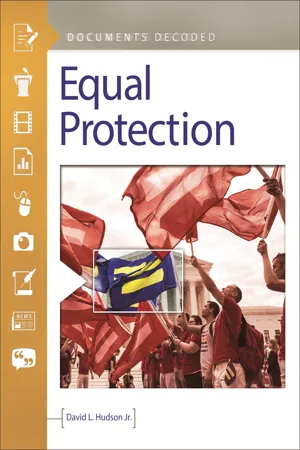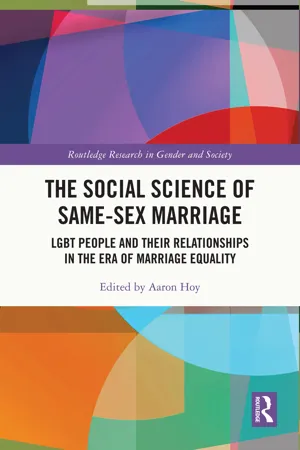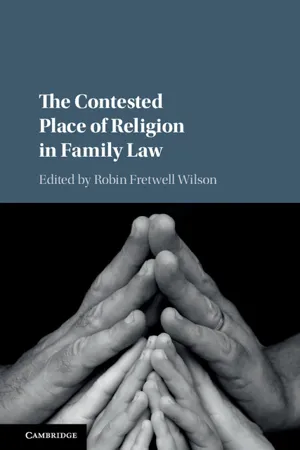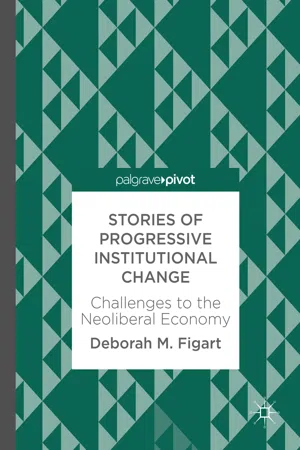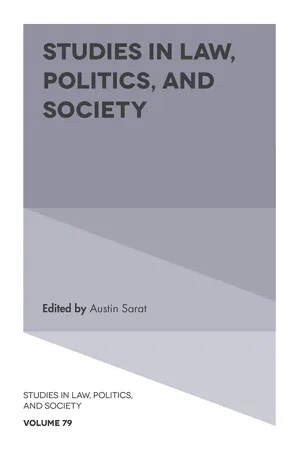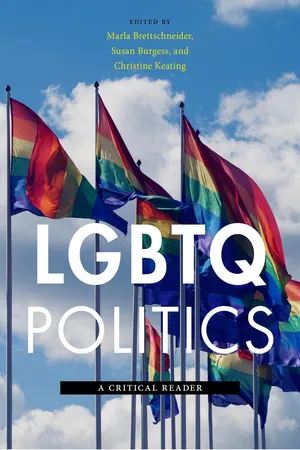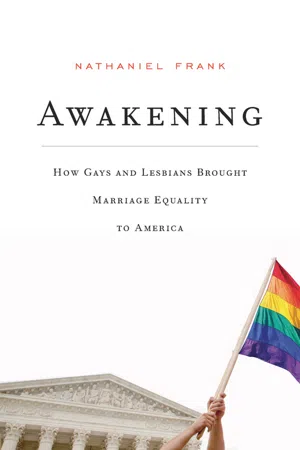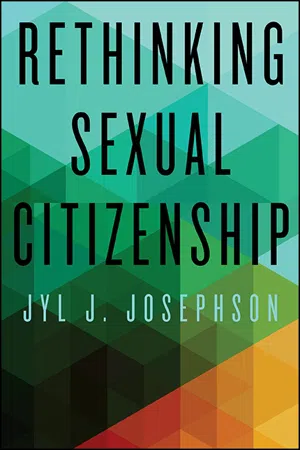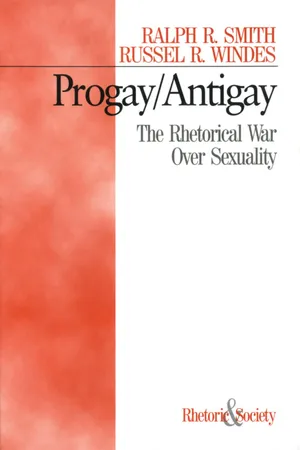Politics & International Relations
Obergefell v. Hodges
"Obergefell v. Hodges" was a landmark U.S. Supreme Court case in 2015 that legalized same-sex marriage nationwide. The case challenged state bans on same-sex marriage and argued that they violated the Fourteenth Amendment's Equal Protection Clause. The Court's ruling established marriage equality as a fundamental right, marking a significant milestone in the LGBTQ+ rights movement.
Written by Perlego with AI-assistance
Related key terms
1 of 5
10 Key excerpts on "Obergefell v. Hodges"
- eBook - ePub
Equal Protection
Documents Decoded
- David L. Hudson Jr.(Author)
- 2018(Publication Date)
- ABC-CLIO(Publisher)
Obergefell v. Hodges June 26, 2015INTRODUCTIONOne of the most landmark decisions in recent memory by the U.S. Supreme Court is Obergefell v. Hodges (2015). In this decision, the court struck down same-sex marriage bans as violative of both the due process clause and the equal protection clause.In the early 1990s, the Hawaii Supreme Court had questioned the constitutionality of a same-sex marriage ban, and a decade later, the Supreme Judicial Court of Massachusetts had explicitly struck down its state ban on same-sex marriages under the Massachusetts Constitution. After that decision, many other states had also invalidated bans on same-sex marriage.However, other states adamantly refused to legalize same-sex marriage or even to recognize same-sex marriages from other countries. This resulted in a state of legal uncertainty for many same-sex couples. Eventually, the U.S. Supreme Court would address the question—and the justices finally did in the Obergefell decision.Justice Kennedy 1 delivered the opinion of the Court.The Constitution promises liberty to all 2 within its reach, a liberty that includes certain specific rights that allow persons, within a lawful realm, to define and express their identity. The petitioners in these cases seek to find that liberty by marrying someone of the same sex and having their marriages deemed lawful on the same terms and conditions as marriages between persons of the opposite sex.. . . These cases come from Michigan, Kentucky, Ohio, and Tennessee ,3 - eBook - ePub
The Social Science of Same-Sex Marriage
LGBT People and Their Relationships in the Era of Marriage Equality
- Aaron Hoy(Author)
- 2022(Publication Date)
- Routledge(Publisher)
Chapter 1 From the political to the personal: LGBT people and their relationships in the era of marriage equality An introduction Aaron HoyDOI: 10.4324/9781003089995-1On June 26, 2015, the US Supreme Court issued its decision in Obergefell v. Hodges, the landmark case that finally, after decades of activism and struggle, legalized same-sex marriage across the US. At the time, I was a graduate student in sociology living in Syracuse, New York. When I first saw the headline announcing the decision on Facebook, I instantly leapt up and rushed downtown to join a victory rally that had been planned days in advance by several community organizations and activists. Similar rallies popped up all over the country, as lesbian, gay, bisexual, and transgender (LGBT) people and their allies celebrated a hard-fought victory that had been many years in the making. In Syracuse, excitement filled the air, as if those who had gathered could not contain their overwhelming joy. Smiles beamed as people offered kind words of congratulations and hugs to others, most of them likely total strangers. As they drove by, cars honked their horns in support, and even a few police officers flashed their lights and sounded their sirens, a sign of support that I remember thinking stood in stark contrast to the hostility LGBT people often experience with police. After an hour or so, the crowd surrounded the steps of a historically progressive church and listened attentively as a handful of local marriage equality activists spoke about the various meanings of the Obergefell decision – how it represented, among other things, a triumph of love over hate, respect and security for LGBT people and their families, and a major step toward full equality for the LGBT community. No matter how they interpreted the decision, most at the rally seemed to agree that Obergefell - Robin Fretwell Wilson(Author)
- 2018(Publication Date)
- Cambridge University Press(Publisher)
For this reason, the lasting impact of Obergefell may not be its recogni- tion of same-sex marriage in the face of religious dissent. To the contrary, if Justice Roberts’s dissent is correct, Obergefell’s sword may be the precise remedy for which many citizens – who are vulnerable to the harms arising from the lack of state intervention – have been waiting. 374 Kari E. Hong 15 Transformational Marriage The Religious Case for Supporting Same-Sex Marriage Robin Bradley Kar Professor of Law and Philosophy, University of Illinois College of Law When the Supreme Court found a constitutional right to same-sex marriage in Obergefell v. Hodges, 1 it settled a legal question for the nation. In the view of many, it nevertheless deepened a preexisting culture war over the role of religion in family life. Some conservative writers now argue that Obergefell requires an enduring response from the Religious Right, which is national in scale and modeled on the pro-life movement. If that were to occur, Obergefell may end up functioning like Roe v. Wade 2 – that is, as a central and seemingly intractable source of political, cultural, and legal division in the United States for many years to come. Though the term “culture war” can be used in many ways, it derives from the German “Kulturkampf,” which originally referred to a conflict between religious and secular authorities in 19th-century Germany. 3 The conflict was over how much authority the Church and its official religious doctrines should have in shaping matters of law and public policy.- eBook - PDF
Stories of Progressive Institutional Change
Challenges to the Neoliberal Economy
- Deborah M. Figart(Author)
- 2017(Publication Date)
- Palgrave Macmillan(Publisher)
The Windsor decision set off a “domino effect” (Ball 2015), as dis- trict courts and appellate courts drew on its reasoning to strike down the bans against same-sex marriage in state after state. In all but one of the numerous cases in the United States Courts of Appeals (the level immediately below the Supreme Court), the lower courts had found that excluding same-sex couples from marrying violates the U.S. Constitution. By 2015, when the U.S. Supreme Court heard the Obergefell case, only fourteen state marriage bans were left standing. 8 TRANSFORMING LEGAL RIGHTS AND SOCIAL VALUES … 109 James Obergefell had lost his longtime partner, John Arthur, to Amyotrophic Lateral Sclerosis (ALS or “Lou Gehrig’s Disease”) in 2013. When John was very ill, they flew from Ohio to Maryland on a medical jet, married on the tarmac, and returned to Ohio to demand that their out-of-state legal marriage be recognized in life and on John’s death cer- tificate. It was not. As Obergefell wound its way through the courts, it was combined with other cases, so that eventually there were 32 couples seeking constitu- tional recognition of marriage equality. The Obergefell v. Hodges deci- sion was announced 2 years to the day after Windsor. Same-sex couples may now marry in all 50 US states and the District of Columbia. The United States was finally catching up in a world in which 17 countries had already legalized gay marriage, including Ireland (with Catholicism as the predominant religion), whose citizens had approved marriage equality in a referendum on May 22, 2015. Both the Windsor and Obergefell decisions affirmed that deny- ing equal protection to a group of people violates human dignity. As Roberta Kaplan reflects: “[i]n his opinion for the Court in Windsor, Justice Kennedy uses the word ‘dignity’ eleven times in 23 pages” (quoted in Grindley 2014). - eBook - ePub
- Austin Sarat(Author)
- 2019(Publication Date)
- Emerald Publishing Limited(Publisher)
17Robert’s narrative casts the Court as the unruly instigator of political conflict and, by contrast, those with lingering discomforts about same-sex marriage as the protectors of the tradition of American deliberative politics and democratic decision-making. Ultimately, the Chief Justice all but invites opponents of same-sex marriage to agitate not only against Obergefell but against the Court itself and, by extension, against an entire branch of government that appears increasingly controlled by a caste of elites, eager to remake society “according to its own ‘new insight’ into the nature of injustice” (Obergefell v. Hodges , 2015, p. 3). “[H]owever heartened the proponents of same-sex marriage might be on this day,” admonishes Roberts, “it is worth acknowledging what they have lost, and lost forever, the opportunity to win the true acceptance that comes from persuading their fellow citizens of the justice of their cause” (Obergefell v. Hodges , 2015, p. 27). Even as he acknowledges the “considerable success” that same-sex marriage supporters have achieved in persuading fellow citizens through the democratic process to adopt their view, Roberts darkly assures such Americans that this trajectory of success “ends today” (Obergefell v. Hodges , 2015, p. 2).It is in the immediate wake of these predictions that Roberts turns to the matter of religious free exercise – and, more specifically, to his indictment of the majority’s dissimulating assurance of free exercise protection for those opposed on religious grounds to the legalization of same-sex marriage. “Many good and decent people oppose same-sex marriage as a tenet of faith, and their freedom to exercise religion is – unlike the right imagined by the majority – actually spelled out in the Constitution” (Obergefell v. Hodges , 2015, p. 27). Roberts’ admonition does not merely furnish an opening into his critique of the “belief-centered” formulation of religion that Kennedy proffers to traditional marriage advocates in the face of their legal defeat, it offers a forceful reminder to his audience that, in the ensuing conflict between supporters and opponents of same-sex marriage, only one of these camps has the plain text of the Constitution on its side. In this sense, he places Obergefell at the center not merely of a burgeoning conflict between supporters and opponents of same-sex marriage but a more far-reaching conflict between the free exercise clause and the very branch of government tasked with defending it. It requires little stretch of the imagination to perceive the manner in which such a depiction invites a particular reader to think of Obergefell - eBook - ePub
- Frances Hamilton, Guido Noto La Diega, Frances Hamilton, Guido Noto La Diega(Authors)
- 2020(Publication Date)
- Routledge(Publisher)
68Conclusion
This is an area that lacks certainty that can only really begin to be achieved through harmonisation as a consequence of large-scale migration. Regardless of this need for change, it is anticipated that, as a result of some Member States taking a very different view of same-sex marriage than others, such an approach could be criticised for going ‘too far, too fast.’ The pragmatic reality is rather different; Obergefell, combined with the recent decision in Coman, demonstrates that harmonisation is achievable in spite of the potential for resistance from some Member States.In making its judgement in Obergefell, the US Supreme Court recognised the uncertainty faced by same-sex couples crossing state borders, and the problems they may face as a consequence of non-recognition of their marital status. They, therefore, sought to rectify this despite the controversy that would surround such a decision. In doing so, they act as a comparator and an example of what can be achieved. With a very similar landscape in respect of differing state laws, the court was able to achieve harmonisation of a higher order than that proposed for the EU, by harmonising substantive law on the area. This, in turn, demonstrates that the proposition is achievable, which is then furthered by the recent judgement in Coman, as all Member States are now required to recognise same-sex marriage for at least one purpose. Straddling these cases, it is argued that harmonisation of the choice of law rules for same-sex relationships across the EU is achievable. Whilst some commentators may criticise such an approach,69 Obergefell is a precedent for harmonisation within this area, and provides evidence that this is essential and should be achieved. This is furthered by the Coman decision, which requires all Member States to recognise same-sex marriages for the purpose of free movement, and acts as a stepping stone to the further recognition required in terms of all same-sex marriages being recognised that have been lawfully entered into, and have been subsisting for a reasonable period of time. Thus, whilst criticism may be levelled at the recommendation of harmonisation, the combined effect of Obergefell and Coman - eBook - ePub
LGBTQ Politics
A Critical Reader
- Marla Brettschneider, Susan Burgess, Christine Keating(Authors)
- 2017(Publication Date)
- NYU Press(Publisher)
In response to arguments that same-sex marriage foreclosed democratic processes, Justice Kennedy wrote, [T]here has been far more deliberation than this argument acknowledges. There have been referenda, legislative debates, and grassroots campaigns, as well as countless studies, papers, books, and other popular and scholarly writings. There has been extensive litigation in state and federal courts.… Judicial opinions addressing the issue have been informed by the contentions of parties and counsel, which, in turn, reflect the more general, societal discussion of same-sex marriage and its meaning that has occurred over the past decades. As more than 100 amici make clear in their filings, many of the central institutions in American life—state and local governments, the military, large and small businesses, labor unions, religious organizations, law enforcement, civic groups, professional organizations, and universities—have devoted substantial attention to the question. (Obergefell v. Hodges, slip op. 23) Obergefell met considerably more controversy than Lawrence, but I do not anticipate Roe -type backlash because, in the main, same-sex marriage was vetted more fully in political discourses and accepted by a majority of Americans before the Court acted. The same Roe Court could have recognized same-sex marriages in 1972 when two men challenged Minnesota laws denying them the right to marry. Instead, the Court declined even to recognize that the issue of same-sex marriage involved federal constitutional questions, neither questions of liberty nor questions of equality. The Court dismissed the case “for want of a substantial federal question” (Baker v. Nelson 1972). Only three years after Stonewall, public support for same-sex marriage would have been as negligible as the Court suggested. Not until the tide of public support for same-sex marriage tipped 50 percent did the Court grant certiorari for same-sex marriage controversies - eBook - PDF
Awakening
How Gays and Lesbians Brought Marriage Equality to America
- Nathaniel Frank(Author)
- 2017(Publication Date)
- Belknap Press(Publisher)
334 Countless people—it is impossible to put a number on it— were responsible for getting the gay rights movement and the nation to the moment in 2015 when same-sex love was poised to land on equal legal footing with heterosexual love. Scores of lawsuits had been filed for mar-riage equality. Now six of them, from four states, were consolidated into one case for argument before the Supreme Court in Obergefell v. Hodges. That left a major question for LGBTQ legal advocates, now consisting not just of longtime movement activists but also numerous lawyers from pri-vate firms who had built on their years of work and leaned on their care-fully crafted legal arguments to bring suits of their own: who would have the honor—and responsibility—of arguing what might be the final case on the freedom to marry, before the highest court in the land? It was not an easy decision to make. In granting Supreme Court re-view, the justices indicated they would devote an unusually long period of two and a half hours to oral arguments, which would be divided into two questions. Question #1 was “Does the Fourteenth Amendment require a state to license a marriage between two people of the same sex?” Question #2 was “Does the Fourteenth Amendment require a state to recognize a marriage between two people of the same sex when their marriage was lawfully licensed and performed out-of-state?” If the Court answered yes in Question #1, then Question #2 was moot, while if it answered yes only in Question #2, then gay couples could function as married everywhere 16 “ It Is So Ordered ” m a rri age equa li t y come s to a ll fif t y s tat e s “It Is So Ordered” 335 but might have to travel to another state to actually get married, some-thing that was not always easy, as the stories of Windsor and Obergefell had shown. - eBook - ePub
- Jyl J. Josephson(Author)
- 2016(Publication Date)
- SUNY Press(Publisher)
4 Defense of Marriage Acts and the Politics of Sexual Regulation After careful consideration, the President has concluded that … classifications based on sexual orientation should be subject to a more heightened standard of scrutiny. The President has also concluded that Section 3 of DOMA, as applied to legally married same-sex couples, fails to meet that standard and is therefore unconstitutional. Given that conclusion, the President has instructed the Department not to defend the statute in such cases. I fully concur with the President’s determination. —Attorney General Eric Holder, February 23, 2011 For me personally it is important to … affirm that I think same sex couples should be able to get married. —President Barack Obama, May 9, 2012 DOMA seeks to injure the very class New York seeks to protect. By doing so it violates basic due process and equal protection principles applicable to the Federal Government. —Justice Kennedy, majority opinion, Windsor v. U.S., June 26, 2013 On June 26, 2015, the Supreme Court handed down its decision in Obergefell v. Hodges (2015). The decision was a major victory for democracy and political inclusion, making marriage available to same-sex couples throughout the United States. This chapter provides an overview of how the law and policy of sexual citizenship and marriage changed, from the adoption of the Defense of Marriage Act (DOMA) in 1996 to the historic Obergefell decision. Of the three policy areas and the target populations considered in this volume, the federal Defense of Marriage Act (DOMA) and the politics of same-sex marriage has certainly been the most dynamic policy. From overwhelming bipartisan support in Congress in 1996, this law, signed by a Democratic president, has now been found unconstitutional by the Supreme Court. Public opinion on same-sex marriage has changed from overwhelming opposition to about an even split between supporters and opponents in national opinion polls - eBook - PDF
Progay/Antigay
The Rhetorical War Over Sexuality
- Ralph R. Smith, Russel R. Windes(Authors)
- 2000(Publication Date)
- SAGE Publications, Inc(Publisher)
Until the early-1990s, dis-cussion largely occurred in the courts where suits advancing claims on be-half of same-sex couples met with consistent rejection. Decisions denying the legal validity of gay marriage were based on the concept that only male/female marriage is traditional, and that there is no fundamental right to marry (Eskridge, 1996, pp. 91, 98-99, 131). Opponents of judi-cial recognition of gay marriage were prepared to advance the argument that the state has a compelling interest in restricting marriage to male/ female unions on the basis of fostering procreation and avoiding state ap-proval of homosexuality (pp. 137-138). Because of the possibility that the judiciary in one state, Hawaii, would rule in favor of same-sex marriage, a major change in the nature of the dis-cussion took place in 1993. On May 5, the Hawaii Supreme Court found in the case of Baehr v. Lewin that the exclusion of same-sex couples was discriminatory under the Hawaii Constitution. The case was remanded for trial to determine if such discrimination is permissible because it is compelled by state interest (Eskridge, 1996, p. 5). The Hawaii Supreme Court relied on gender discrimination as the basis of its decision. The Court did not find a state constitutional right to marry, muchless a right grounded in the federal Constitution. The decision did not incorporate the claims of progay advocates that exclusion of gay people from the right to marry violates the equal protection of the laws understood as either the right to privacy or unlawful discrimination on the basis of sexual orienta-tion (p. 131). To both traditionalists and progay advocates, gay marriage is a singu-larly important issue, a public policy question which both sides could ad-vantageously target. Hunter (1991) points out that the family is an im-portant symbolic territory because the social arrangements and relationships found there are very much a microcosm of those in the larger social order (p. 173).
Index pages curate the most relevant extracts from our library of academic textbooks. They’ve been created using an in-house natural language model (NLM), each adding context and meaning to key research topics.
